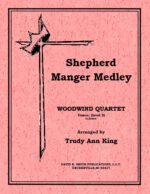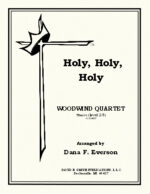| Instrument | |
|---|---|
| Level | 3 |
| Occasion | |
| Theme | O Little Town Of Bethlehem |
| Writer | |
| Publisher | |
| Copyright | 1994 |
O Lord How Excellent/Name
$14.95
Related products
-
-
What Child Is This (unacc)
$8.00Score for four flutes the piece openings with a quasi round device and then establishes a more straight forward rendition of the tune. The final section becomes quite florid with intricately woven countrapuntal voicing.
-
Tis So Sweet To Trust
$8.00A quartet for 2 flutes and 2 clarinets with opt. parts for oboe, B. clar., bassoon and Alto sax. After a brief introduction the flutes carry the melodic material and then shifting the chorus to the clarinets. A modulation shifts the attention to the clarinet melody with punctuation remarks in the other instruments. Further transition moves to another modulation where thematic motifs are passed around in a fughetta fashion where it then becomes more choral in nature ending in a solemn statement.
-
Be Thou My Vision
$9.00A woodwind quartett scored for flutes, clarinets, and other woodwind instruments, this piece presents itself in a gentle, thought provoking manner. The middle section is faster, giving a heightened sense of thought worthiness.
-
-
Holy, Holy, Holy
$9.00Written for flute, oboe, clarinet or saxophone this pieces creates a solemn presence by the way it interweaves the various parts together. It would work well for a meditation.
-
What A Friend
$9.00Scored for Saxophone quartet (A-A-T-B) with opt. Soprano for first Alto. The introduction starts with the First Alto playing a melodic motif, ever rising to a climatic point and then settling down to the theme- first presented in the First and Tenor parts weaving in and out producing a flowing texture, then joined by the Second Alto and eventually the Baritone. The chorus section of the hymn is a constant weaving of the four parts both harmonically and rhythmically. The next section becomes more active rhythmically adding tension until it settles down into a sweet aura of sound with gentle nudges of harmonic alteration. The final measures give an atmosphere of rest and solace.
-
Holy, Holy, Holy
$7.00Written for Clarinet quartet, this pieces creates a solemn presence by the way it interweaves the various parts together. It would work well for a meditation.









